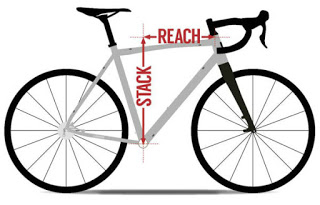How big is the bike frame I need?
For an ideal cycling experience, it is important that you buy a bike with the correct frame size. The correct frame size and bike configuration are essential for your comfort and to avoid pain and injury. Plus, with the right riding position, you pedal more efficiently and quickly.
Unfortunately, it is common practice to recommend frame size based on leg height or length. This is an easy method, but it is not a good method. The correct method for determining the optimal frame size is more complex. We'll explain this in detail in this article.
Do not select the frame size based on your height or length of your leg!
Determining the size of the frame based on the height or length of the legs is like buying jeans based only on length, hoping that the waist also fits. You may want to take a chance with a pair of jeans, but this is certainly not recommended when buying a road bike. If a pair of jeans doesn't fit well, you usually have a few others hanging in the closet. If a bike does not fit properly, this can result in poor performance, pain, and injury.
The two most important elements of your cycling position are the position of the saddle and the position of the handlebars. The size of the frame only tells you something about the possible heights of the saddle. It does not provide information on the possible position of the handlebars.
Two people of the same height may require a completely different frame size. For example, someone with relatively short legs will need a larger structure compared to someone of the same height with relatively long legs. That sounds contradictory, but it certainly isn't.
The size of the frame is based on the length of the saddle tube (and therefore on the height of the saddle). And while saddle height is the most important configuration of the bike, it's not as important to determine the size of the frame. Normally, you can adjust the height of the saddle to more than 20 centimeters. And therefore, you will be able to achieve the desired saddle height with multiple frame sizes of the same bike model. Much more important to select the correct size of the bike are the battery and the range of the frame, because they have a very small adjusted range. And often you need to replace the bike parts to make an adjustment.
The range is the horizontal distance from the center of the bottom bracket to the center of the top of the upper tube. The range therefore determines the range of the handlebar saddle (horizontal distance from the saddle to the handlebar) of your bike. If we now take the example of a person with relatively short legs, then that person automatically also has a relatively long torso. Due to the short legs, its saddle is lower and more advanced than someone with an average leg length. And because of his relatively long torso, the handlebars should be placed farther away from the saddle. In other words, the person with relatively short legs needs a much longer structure (larger range) and therefore a larger structure size. For almost all road bike models, the saddle of the larger frame can be low enough for that person's relatively short legs.

The stack is the vertical difference in distance/height between the center of the bottom bracket and the center of the top of the main tube. Your ideal stack depends mainly on your desired riding position. If you want a deep aerodynamic position, your handlebars should be placed too low and you need a small stack. If you want more comfort and sit relatively upright, you'll need a much larger stack. That's why many professional cyclists walk in a much smaller frame size than you'd expect based on their height.

